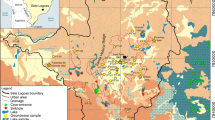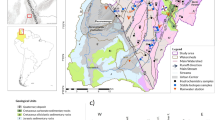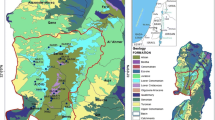Abstract
Karstic limestone formations in the Mediterranean basin are potential water resources that can meet a significant portion of groundwater demand. Therefore, it is necessary to thoroughly study the hydrogeology and hydrogeochemistry of karstic mountain regions. This paper presents a detailed hydrogeological and hydrogeochemical characterization of the Nif Mountain karstic aquifer system in western Turkey, an important recharge source for the densely populated surrounding area. Based on the geological and hydrogeological studies, four major aquifers were identified in the study area including the allochthonous limestone in Bornova flysch, conglomerate-sandstone and clayey-limestone in Neogene series, and the Quaternary alluvium. Physicochemical characteristics of groundwater were measured in situ, and samples were collected at 59 locations comprised of springs and wells. Samples were analyzed for major ions, isotopic composition, arsenic, boron and heavy metals among other trace elements. It was found that the hydrogeological structure is complex with many springs having a wide range of discharge rates. High-discharge springs originate from allochthonous limestone units, whereas low-discharge springs are formed at the contacts with claystone and limestone units. Using stable isotope analysis data, a δ18O-deuterium relationship was obtained that lies between the Mediterranean meteoric and mean global lines. Tritium analyses showed that low-discharge springs originating from contact zones had longer circulation times compared to the high-discharge karstic springs. Furthermore, hydrogeochemical data revealed that groundwater quality significantly deteriorated as water moved from the mountain to the plains. Heavy metal, arsenic and boron concentrations were generally within drinking-water quality standards with a few exceptions occurring in residential and industrial areas located at the foothills of the mountain. Elevated arsenic concentrations were related to local geologic formations, which are likely to contain oxidized sulfite minerals in claystones. It is concluded that Nif Mountain overall has a significant potential to provide high-quality water with a safe yield of at least 50 million m3/year, which corresponds to about 28% of the mean annual inflow to the Tahtali reservoir, a major water resource for the city of Izmir.










Similar content being viewed by others
References
Ayers RS, Westcot DW (1985) Water quality for agriculture. FAO irrigation and drainage paper no. 29, rev. 1. U. N. Food and Agriculture Organization, Rome
Baba A, Sozbilir H (2001) The geology and groundwater quality of the NE-directed Torbali and Kemalpasa plain, West Anatolia. Paper presented at the I. Environmental Geology Symposium (CEVJEO-2001), Izmir, 21–23 March 2001 (in Turkish)
Bajjali W (2006) Recharge mechanism and hydrochemistry evaluation of groundwater in the Nuaimeh area, Jordan, using environmental isotope technique. Hydrogeol J 14:180–191
Biondic B, Biondic R, Kapelj S (2006) Karst groundwater protection in the Kupa river catchment area and sustainable development. Environ Geol 49:828–839
Charideh A, Rahman A (2006) Environmental isotopic and hydrochemical study of water in the karst aquifer and submarine springs of the Syrian coast. Hydrogeol J. DOI:10.1007/s10040-006-0072-x
Demirkiran Z, Cetiner L, Simsek C, Gunduz O, Ocal G (2006) Interactive three-dimensional modeling and characterization of the hydrogeological structure of Kemalpasa. Paper presented at the 30th Annual Fikret Kutman Geology Symposium, 20–23 September, Konya (in Turkish)
DMI (2006) Station report (in Turkish). General Directorate of State Meteorological Service, Izmir Regional Directorate, Izmir, Turkey
Erdogan B, Gungor T (1992) The stratigraphy and tectonic evolution of the northern portions of the Menderes Massive (in Turkish). TPJD Bull C 4/1, Izmir
Fetter CW (2001) Applied hydrogeology. Prentice Hall, Upper Saddle River
Fritz P, Drimmie RJ, Frape SK, O’Shea K (1987) The isotopic composition of precipitation and groundwater in Canada. In: Proceedings of a Symposium on Isotope Techniques in Water Resources Development. IAEA, pp 539–550
Gunay G (2006) Hydrology and hydrogeology of Sakaryabasi karstic springs, Cifteler, Turkey. Environ Geol 51:229–240
Hiscock K (2005) Hydrogeology: principles and practice. Blackwell, Malden, MA
IAEA (2002) Statistical treatment of data on environmental isotopes in precipitation (period 1960–1997). Technical report series no. 331. International Atomic Energy Agency, Vienna
Inci U (1991) The facies and sedimentation conditions of the Miocene-aged terrestrial units of Northern Torbali (Izmir) (in Turkish). MTA J 112:13–26
Kacaroglu F (1999) Review of groundwater pollution and protection in karst areas. Water Air Soil Pollut 113:337–356
Pearson FL, Balderer W, Lossli BE, Lehmann BE, Matter A, Peters TJ, Schmassman H, Gautschi A (1991) Applied isotopes hydrogeology a case study in northern Switzerland. Elsevier, Amsterdam
Rindsberger M, Jaffe SH, Rahamin SH, Gat JR (1990) Patterns of isotopic composition of precipitation in time and space: data from the Israeli storm water collection program. Tellus 42B:263–271
Sen Z (1995) Applied hydrogeology for scientists and engineers. CRC Press, Boca Raton
Simsek C (2002) The hydrogeological investigations for the site selection of the landfill area of the Torbalí Plain. PhD Thesis, Graduate School of Natural and Applied Science, Dokuz Eylul University, Izmir
Sozbilir H (2000) Active faults and potentially active faults; examples from western Anatolia (in Turkish). Paper presented at the BAKSEM Symposium for West Anatolia Earthquake Studies, 24–27 May 2000, Izmir, pp 133–142
White WB (2002) Karst hydrology: recent developments and open questions. Eng Geol 65:85–105
Acknowledgements
This study was funded by the Scientific and Technological Research Council of Turkey (TUBITAK), project no. 104Y290 and the Marie Curie International Reintegration Grant MIRG-CT-2005-029133 within the 6th European Community Framework program. The authors are thankful to Yetkin Dumanoglu and Rahime Polat for their assistance in anion analyses by ion-chromatography.
Author information
Authors and Affiliations
Corresponding author
Additional information
An erratum to this article can be found at http://dx.doi.org/10.1007/s00254-007-0937-x
Rights and permissions
About this article
Cite this article
Simsek, C., Elci, A., Gunduz, O. et al. Hydrogeological and hydrogeochemical characterization of a karstic mountain region. Environ Geol 54, 291–308 (2008). https://doi.org/10.1007/s00254-007-0817-4
Received:
Accepted:
Published:
Issue Date:
DOI: https://doi.org/10.1007/s00254-007-0817-4
Keywords
Profiles
- Orhan Gunduz View author profile




